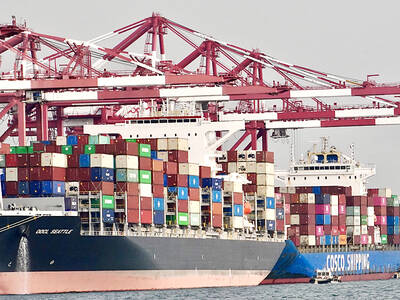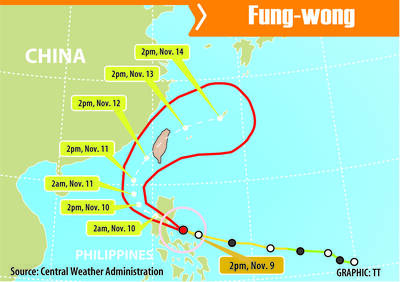Top aides to the leaders of North and South Korea met at the Panmunjom truce village straddling their border yesterday, raising hopes for an end to a standoff that put the rivals on the brink of armed conflict.
The meeting at the demilitarized zone (DMZ) village, known for its sky-blue huts and grim-faced soldiers, was set for half an hour after North Korea’s previously set ultimatum demanding that the South halt its loudspeaker propaganda broadcasts along the border or face military action.
That deadline passed without any reported incidents.

Photo: Reuters
Tension on the Korean Peninsula has been running high since an exchange of artillery fire on Thursday, prompting calls for calm from the UN, the US and North Korea’s only major ally, China. South Korea’s military remained on high alert despite the announced talks, a South Korean Ministry of Defense official said.
South Korean President Park Geun-hye’s national security adviser and her unification minister met North Korean National Defense Commission Vice Chairman Hwang Pyong-so, who is North Korean leader Kim Jong-un’s top military aide, at 6pm.
“The South and the North agreed to hold contact related to the ongoing situation in South-North relations,” Blue House deputy national security adviser Kim Kyou-hyun said in a televised briefing.
Pyongyang on Friday made an initial proposal for a meeting, and Seoul made a revised proposal yesterday seeking Hwang’s attendance, Kim said.
The North’s KCNA news agency also announced the meeting, referring to the South as the Republic of Korea, a rare formal recognition of its rival state, in sharp contrast to the bellicose rhetoric in recent days.
“They need to come up with some sort of an agreement where both sides have saved face. That would be the trick,” Seoul’s Asan Institute for Policy Studies academic James Kim said. “North Korea will probably demand that the broadcasts be cut, and they may even come to an impasse on that issue.”
North Korea, technically still at war with the South after their 1950-53 conflict ended in a truce, not a peace treaty, had declared a “quasi-state of war” in front-line areas and set the deadline for Seoul to halt the broadcasts from loudspeakers placed along the border.
“The situation on the Korean Peninsula is now inching close to the brink of a war due to the reckless provocations made by the South Korean military war hawks,” the North’s KCNA news agency said earlier.
“The fact that these powerful officials who represent South and North Korea’s leaders are meeting means this is a great time to turn the crisis into opportunity,” Seou’s University of North Korean Studies professor Yang Moo-jin said. “It is a breakthrough.”

The Central Weather Administration (CWA) yesterday said it expected to issue a sea warning for Typhoon Fung-Wong tomorrow, which it said would possibly make landfall near central Taiwan. As of 2am yesterday, Fung-Wong was about 1,760km southeast of Oluanpi (鵝鑾鼻), Taiwan’s southernmost point, moving west-northwest at 26kph. It is forecast to reach Luzon in the northern Philippines by tomorrow, the CWA said. After entering the South China Sea, Typhoon Fung-Wong is likely to turn northward toward Taiwan, CWA forecaster Chang Chun-yao (張峻堯) said, adding that it would likely make landfall near central Taiwan. The CWA expects to issue a land

Taiwan’s exports soared to an all-time high of US$61.8 billion last month, surging 49.7 percent from a year earlier, as the global frenzy for artificial intelligence (AI) applications and new consumer electronics powered shipments of high-tech goods, the Ministry of Finance said yesterday. It was the first time exports had exceeded the US$60 billion mark, fueled by the global boom in AI development that has significantly boosted Taiwanese companies across the international supply chain, Department of Statistics Director-General Beatrice Tsai (蔡美娜) told a media briefing. “There is a consensus among major AI players that the upcycle is still in its early stage,”

The Central Weather Administration (CWA) yesterday said it is expected to issue a sea warning for Typhoon Fung-wong this afternoon and a land warning tomorrow. As of 1pm, the storm was about 1,070km southeast of Oluanpi (鵝鑾鼻), Taiwan’s southernmost point, and was moving west-northwest at 28 to 32kph, according to CWA data. The storm had a radius of 250km, with maximum sustained winds of 173kph and gusts reaching 209kph, the CWA added. The storm is forecast to pass near Luzon in the Philippines before entering the South China Sea and potentially turning northward toward Taiwan, the CWA said. CWA forecaster Chang Chun-yao (張峻堯) said

PREPARATION: Ferry lines and flights were canceled ahead of only the second storm to hit the nation in November, while many areas canceled classes and work Authorities yesterday evacuated more than 3,000 people ahead of approaching Tropical Storm Fung-wong, which is expected to make landfall between Kaohsiung and Pingtung County this evening. Fung-wong was yesterday morning downgraded from a typhoon to a tropical storm as it approached the nation’s southwest coast, the Central Weather Administration (CWA) said, as it issued a land alert for the storm. The alert applies to residents in Tainan, Kaohsiung, Pingtung and Taitung counties, and the Hengchun Peninsula (恆春). As of press time last night, Taichung, Tainan, Kaohsiung, and Yilan, Miaoli, Changhua, Yunlin, Pingtung and Penghu counties, as well as Chiayi city and county had